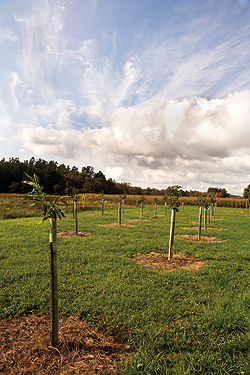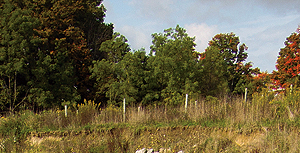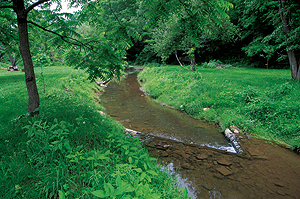Streambanks, Restored: Tackling a Huge Planting Task

This riparian zone in French Creek is an example of the work WPC’s Watershed Conservation Program is doing, with financial support from the Richard King Mellon Foundation.
By the end of April – when the ground had just thawed and many gardeners were just thinking of the annuals they would plant that season – Alysha Trexler and the watershed conservation program team saw their 11,000th tree seedling go into the ground.
Trexler, a watershed projects manager at the Western Pennsylvania Conservancy, hopes to lead the team to plant another 9,000 trees and shrubs in priority watersheds throughout Western Pennsylvania by the end of next spring. In all, more than 20,000 native trees and plants will help create riparian buffers – or vegetative cover near stream banks – improving up to 35,000 linear feet of stream.
That’s more than six miles of creek-side public and private land that will now be home to pin oak (Quercus palustris), elderberry bush (Sambucus nigra) and other native plants.
“Some of these tree seedlings can fit in the palm of your hand,” said Trexler, who’s working with staff in WPC’s Watershed Conservation Program. “It’s a great feeling to know that something so small can grow into a natural conservation tool that can last a hundred years or more.”
The Conservancy received a grant to plant thousands of native trees and shrubs near streams in priority watersheds. These watersheds were selected using geographic information system (GIS) analysis to identify watersheds heavily impacted by sedimentation from streambank erosion. The hope is that these forested buffers will prevent bank erosion, create wildlife habitat and cool water temperatures for aquatic organisms. Stream banks that lack vegetative cover can erode excessively and contribute to excessive sedimentation in the creek.
Based on biodiversity data collected by WPC staff and others, the organization has focused its work on the following priority watersheds:

Buffers near streams, prevent bank erosion, create wildlife habitat and cool water temperatures for aquatic organisms.
- the upper Allegheny region, including French Creek, Brokenstraw Creek and the upper Allegheny tributaries;
- the lower Allegheny and Ohio region, including Buffalo Creek in Washington County;
- Little Mahoning Creek, Loyalhanna Creek and Tubmill Creek;
- the Juniata and Potomac region, including Aughwick Creek, the Raystown Branch of the Juniata River and Kishacoquillas Creek;
- the West Branch Susquehanna region, including Portage Creek, Sinnemahoning Creek and West Branch Susquehanna tributaries;
- Big Sandy Creek;
- Middle Allegheny Tributaries;
- Potomac Tributaries; and
- Youghiogheny Tributaries.
“Many of the streams in these priority watersheds are impaired by excess sediment caused by erosion associated with a lack of woody vegetation,” said Jenifer Christman, associate vice president of watershed conservation.
WPC staff members have been planting trees and shrubs on farmland, pastures, mowed and maintained properties and other stream banks in need of trees. The team’s stocking levels have ranged from 200 trees per acre to about 400 trees per acre.

Adequate vegetative cover on stream banks prevents excessive erosion.
WPC staff members aren’t working alone. The cooperation of volunteers, landowners, residents, community leaders, elected officials and other partners, including county conservation districts, Trout Unlimited Groups, the Pennsylvania Fish and Boat Commission and local Watershed Associations, is necessary to keep the project moving forward.
Late last year, Trexler reached out to residents, landowners, community leaders and partners that do watershed protection in the targeted target areas and solicited help. The team sought out properties near streams that had little or no woody vegetation within 35 feet of the shoreline and had at least 50 feet of bank.
The project’s funding has covered the purchase of the trees and shrubs, tree tubes, stakes and and staff to assist in the planting. The project has been met with such demand that the Conservancy is already looking for additional funding sources in order to continue this initial two-year project.
Participating landowners have agreed to steward and maintain the plants and have committed to protecting the areas for at least the next five years. Stewardship includes conducting annual inspections of the plantings and removal of protective netting on the trees.
Since the objective of the project is to re-establish a wooded area along streams, trees should remain in the area for the lifetime of the species.
In September, the Conservancy will host its first member workday and outing to support this stream bank restoration project. Following a brief training and informational session, volunteers will help plant about 300 tree saplings along French Creek in Crawford County.
